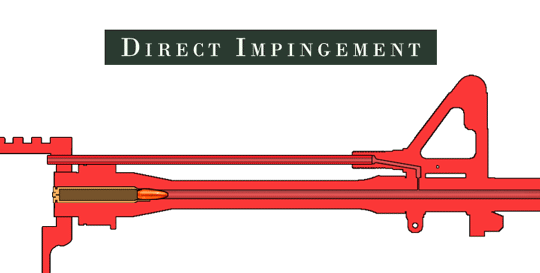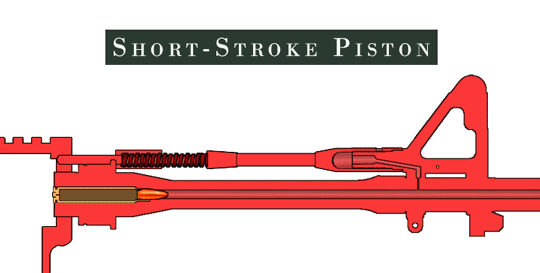
Gas-operated reloading
Encyclopedia

High pressure
High pressure in science and engineering is studying the effects of high pressure on materials and the design and construction of devices, such as a diamond anvil cell, which can create high pressure...
gas from the cartridge
Cartridge (firearms)
A cartridge, also called a round, packages the bullet, gunpowder and primer into a single metallic case precisely made to fit the firing chamber of a firearm. The primer is a small charge of impact-sensitive chemical that may be located at the center of the case head or at its rim . Electrically...
being fired is used to power a mechanism to extract the spent case and chamber a new cartridge. Energy
Energy
In physics, energy is an indirectly observed quantity. It is often understood as the ability a physical system has to do work on other physical systems...
from the gas is harnessed through either a port in the barrel
Gun barrel
A gun barrel is the tube, usually metal, through which a controlled explosion or rapid expansion of gases are released in order to propel a projectile out of the end at a high velocity....
or trap at the muzzle. This high-pressure gas impinges on a surface such as a piston
Piston
A piston is a component of reciprocating engines, reciprocating pumps, gas compressors and pneumatic cylinders, among other similar mechanisms. It is the moving component that is contained by a cylinder and is made gas-tight by piston rings. In an engine, its purpose is to transfer force from...
head to provide motion for unlocking of the action
Firearm action
In firearms terminology, an action is the physical mechanism that manipulates cartridges and/or seals the breech. The term is also used to describe the method in which cartridges are loaded, locked, and extracted from the mechanism. Actions are generally categorized by the type of mechanism used...
, extraction of the spent case, ejection, cocking of the hammer
Hammer (firearm)
thumb|150px|Hammer with an integral [[firing pin]] on a [[S&W Model 13]] revolver The hammer of a firearm was given its name for both resemblance and functional similarity to the common tool...
or striker, chambering of a fresh cartridge, and locking of the action.
Gas systems
Most current gas systems employ some type of piston. The face of the piston is acted upon by gas from the combustion of the propellant from the barrel of the firearm. Early methods such as Browning's 'flapper' prototype, the Bang rifleM1922 Bang rifle
The Bang M1922 was a semi automatic rifle of US Origin designed by the Danish arms designer Søren Hansen Bang. It was a modification of the 1909 models both chambered in the .30-06 Springfield round. At its field trials in 1919 and again in 1927, the demonstrator of the rifle was its designer Søren...
, and Garand rifle
M1 Garand
The M1 Garand , was the first semi-automatic rifle to be generally issued to the infantry of any nation. Called "the greatest battle implement ever devised" by General George S...
used relatively low-pressure gas from at or near the muzzle. This, combined with more massive operating parts, reduced the strain on the mechanism. To simplify and lighten the firearm, gas from nearer the chamber needed to be used. This gas is of extremely high pressure
Pressure
Pressure is the force per unit area applied in a direction perpendicular to the surface of an object. Gauge pressure is the pressure relative to the local atmospheric or ambient pressure.- Definition :...
and has sufficient force to destroy a firearm unless it is regulated somehow. Several methods are employed to regulate the energy. The M1 carbine
M1 Carbine
The M1 carbine is a lightweight, easy to use semi-automatic carbine that became a standard firearm for the U.S. military during World War II, the Korean War and the Vietnam War, and was produced in several variants. It was widely used by U.S...
incorporates a very short piston, or "tappet", that moves only a fraction of an inch prior to stopping against a shoulder recess. Excess gas is then vented back into the bore
Gun barrel
A gun barrel is the tube, usually metal, through which a controlled explosion or rapid expansion of gases are released in order to propel a projectile out of the end at a high velocity....
. The M14 rifle
M14 rifle
The M14 rifle, formally the United States Rifle, 7.62 mm, M14, is an American selective fire automatic rifle firing 7.62x51mm NATO ammunition. It was the standard issue U.S. rifle from 1959 to 1970. The M14 was used for U.S...
and M60
M60 machine gun
The M60 is a family of American general-purpose machine guns firing 7.62×51mm NATO cartridges from a disintegrating belt of M13 links...
GPMG
General purpose machine gun
A general-purpose machine gun is a multi-purpose weapon: it is a machine gun firing a full-power rifle cartridge and which can be used in a variety of roles, from a bipod- or tripod-mounted infantry support weapon to a helicopter door gun or a vehicle-mounted support weapon...
use the White expansion and cutoff system to stop (cut off) gas from entering the cylinder once the piston has traveled a short distance. Most systems, however, vent excess gas into the atmosphere through slots, holes, or ports.


Direct impingement
The direct impingement method of operation vents gas through a tube to the working parts of a rifle where they directly impinge on the bolt carrier. Rifles that use this system include the Swedish Ljungman Ag m/42Ag m/42
The Automatgevär m/42 is a Swedish semi-automatic rifle in limited use by the Swedish Army from 1942 until the 1960s.-History:...
, M16
M16 rifle
The M16 is the United States military designation for the AR-15 rifle adapted for both semi-automatic and full-automatic fire. Colt purchased the rights to the AR-15 from ArmaLite, and currently uses that designation only for semi-automatic versions of the rifle. The M16 fires the 5.56×45mm NATO...
and French MAS-49
MAS-49
The MAS-49 is a French semi-automatic military rifle that replaced the diverse collection of aging bolt-action rifles that were in French service after the end of World War II...
. This system has the advantage of having the absolute minimum of recoiling action parts, resulting in the minimum possible weapon disturbance due to balance shifting during the action cycle as well as reducing overall weapon weight. It has the disadvantage of the propellant gas (and the accompanying fouling) being blown directly into the action parts. The DI operation increases the amount of heat that is deposited in the receiver while firing of the M16 and causing essential lubricant to be "burned off". This requires frequent and generous applications of appropriate lubricants. Lack of proper lubrication is the most common source of weapon stoppages or jams. A further disadvantage is that the bolt, extractor, ejector, pins, and springs are heated by this high-temperature gas. This heat may change the temper of the metal, resulting in reduced life of these parts and shortening time between failures.
Short-stroke piston
With a short-stroke or tappet system, the piston moves separately from the bolt group. It may directly push the bolt group parts as in the M1 carbineM1 Carbine
The M1 carbine is a lightweight, easy to use semi-automatic carbine that became a standard firearm for the U.S. military during World War II, the Korean War and the Vietnam War, and was produced in several variants. It was widely used by U.S...
or operate through a connecting rod or assembly as in the Armalite AR-18 or the SKS
SKS
The SKS is a Soviet semi-automatic rifle chambered for the 7.62x39mm round, designed in 1943 by Sergei Gavrilovich Simonov. SKS-45 is an acronym for Samozaryadnyj Karabin sistemy Simonova, 1945 Simonov system, 1945), or SKS 45. The Sks is a scaled down version of the PTRS-41 anti-tank rifle also...
. In either case, the energy is imparted in a short, violent push and the motion of the gas piston is then arrested allowing the bolt carrier assembly to continue through the operating cycle through kinetic energy
Kinetic energy
The kinetic energy of an object is the energy which it possesses due to its motion.It is defined as the work needed to accelerate a body of a given mass from rest to its stated velocity. Having gained this energy during its acceleration, the body maintains this kinetic energy unless its speed changes...
. This has the advantage of reducing the total mass of recoiling parts. This, in turn, enables better control of the weapon due to less mass needing to be stopped at either end of the bolt carrier travel. These sudden stops on other systems disrupt the weapon's point of aim, especially with light weapons in full-automatic fire. The primary disadvantage of this system is that it relies more heavily on spring pressure and less on bolt mass for the kinetic energy to chamber a round and lock the breech. Additional benefits of short-stroke piston design are ease of maintenance, longer service life of various components in the rifle. At the same time service intervals are increased due to this design's ability to keep most moving parts operating cooler and cleaner.
Long-stroke piston
With a long-stroke system, the piston is mechanically fixed to the bolt group and moves through the entire operating cycle. This system is used in weapons such as the Bren light machine gun, AK-47AK-47
The AK-47 is a selective-fire, gas-operated 7.62×39mm assault rifle, first developed in the Soviet Union by Mikhail Kalashnikov. It is officially known as Avtomat Kalashnikova . It is also known as a Kalashnikov, an "AK", or in Russian slang, Kalash.Design work on the AK-47 began in the last year...
, M249 Squad Automatic Weapon
M249 light machine gun
The M249 light machine gun , previously designated the M249 Squad Automatic Weapon , and formally written as Light Machine Gun, 5.56 mm, M249, is an American version of the Belgian FN Minimi, a light machine gun manufactured by the Belgian company FN Herstal . The M249 is manufactured in the...
, and M1 Garand
M1 Garand
The M1 Garand , was the first semi-automatic rifle to be generally issued to the infantry of any nation. Called "the greatest battle implement ever devised" by General George S...
. The primary advantage of the long-stroke system, beyond design simplicity and robustness, is that the mass
Mass
Mass can be defined as a quantitive measure of the resistance an object has to change in its velocity.In physics, mass commonly refers to any of the following three properties of matter, which have been shown experimentally to be equivalent:...
of the piston rod adds to the momentum
Momentum
In classical mechanics, linear momentum or translational momentum is the product of the mass and velocity of an object...
of the bolt carrier enabling more positive extraction, ejection, chambering, and locking. The primary disadvantage to this system is the disruption of the point of aim due to the center of mass
Center of mass
In physics, the center of mass or barycenter of a system is the average location of all of its mass. In the case of a rigid body, the position of the center of mass is fixed in relation to the body...
changing during the action cycle and energetic and abrupt stops at the beginning and end of bolt carrier travel.
Gas trap
A gas trap system is similar to long-stroke operation, however gas is 'trapped' after leaving the muzzle. The Bang rifleM1922 Bang rifle
The Bang M1922 was a semi automatic rifle of US Origin designed by the Danish arms designer Søren Hansen Bang. It was a modification of the 1909 models both chambered in the .30-06 Springfield round. At its field trials in 1919 and again in 1927, the demonstrator of the rifle was its designer Søren...
, early 'gas-trap Garand', and Gewehr 41
Gewehr 41
The Gewehr 41 rifles, commonly known as the G41 or G41, were semi-automatic rifles used by Nazi Germany during World War II-Background:...
operated this way. These systems are longer, heavier, dirtier and more complex; however, they do use lower pressure gas and do not require that a hole be drilled in the barrel, two advantages that are largely negated by their disadvantages.
Floating chamber
Early machine guns were expensive to operate. The United States Army wanted to train machine gun crews with less-expensive ammunition. To do this, they needed the .22LR cartridge to operate firearms designed to use the .30-06 cartridge. David Marshall Williams invented a method that involved a separate floating chamber that acted as a gas piston with combustion gas impinging directly on the front of the floating chamber. The Colt Service Ace conversion kit utilized this system, which allows a much heavier slide than other conversions operating on the unaugmented blowback mechanismBlowback (arms)
Blowback is a system of operation for self-loading firearms that obtains energy from the motion of the cartridge case as it is pushed to the rear by expanding gases created by the ignition of the propellant charge....
. A floating chamber provides additional force to operate the heavier slide, providing a felt recoil
Recoil
Recoil is the backward momentum of a gun when it is discharged. In technical terms, the recoil caused by the gun exactly balances the forward momentum of the projectile and exhaust gasses, according to Newton's third law...
level similar to that of a full power cartridge.
Muzzle booster

The French Chauchat
Chauchat
The Chauchat , was the standard light machine gun of the French Army during World War I. Under the leadership of General Joseph Joffre, it was commissioned into the French Army in 1916. It was also widely used by the US Army in 1917-1918 and by six other nations: Belgium, Greece, Poland, Russia,...
, German MG-42 machine gun, and some other recoil operated firearms use a gas trap style mechanism to provide additional energy to 'boost' the energy provided by recoil. This 'boost' provides higher rates of fire and/or more reliable operation. It is alternately called a gas assist, and may also be found in some types of blank-firing adapters.
Gas-delayed blowback
The boltBolt (firearm)
A bolt is a mechanical part of a firearm that blocks the rear of the chamber while the propellant burns.In manually-operated firearms, such as bolt-action, lever-action, and pump-action rifles and shotguns, the bolt is held fixed by its locking lugs during firing, forcing all the expanding gas...
is not locked but is pushed rearward by the expanding propellant
Propellant
A propellant is a material that produces pressurized gas that:* can be directed through a nozzle, thereby producing thrust ;...
gases as in other blowback-based designs. However, propellant gases are vented from the barrel into a cylinder with a piston that delays the opening of the bolt. It is used by Volkssturmgewehr 1-5
Volkssturmgewehr 1-5
The Volkssturmgewehr 1-5 is a set of 5 rifle designs developed by Nazi Germany during the last months of World War II...
rifle, the Heckler & Koch P7 and Steyr GB
Steyr GB
The Steyr GB, is a double-action 9×19mm Parabellum caliber, large-framed semi-automatic pistol. The GB uses a gas-delayed blowback action and has a magazine capacity of 18 rounds...
pistols.
Gas ejection
Patented by August Schuler, the Reform pistol featured a vertical row of barrels that advanced upwards with each shot exposing the fired chamber. As the lower barrel fired, a gas hole between the barrels pressurized the empty barrel enough to eject the case rearward. An extended spur on the hammer prevented the spent case from hitting the firer in the face. The final case required manual extraction.Other autoloading systems
Other autoloading systems are:- Blow forwardBlow forwardBlow-forward is a firearm operation where the barrel is virtually the only moving part of the weapon that is forced forward against a spring by the cartridge pressure and friction of the projectile against the rifling...
firearms lack the use of a bolt but instead a moving barrel that gets dragged forward by the bullet until it leaves the barrel to cycle its action. - BlowbackBlowback (arms)Blowback is a system of operation for self-loading firearms that obtains energy from the motion of the cartridge case as it is pushed to the rear by expanding gases created by the ignition of the propellant charge....
firearms use the expanding gas impinging on the cartridge itself to push the bolt of the firearm rearward. - Recoil operationRecoil operationRecoil operation is an operating mechanism used in locked-breech, autoloading firearms. As the name implies, these actions use the force of recoil to provide energy to cycle the action...
uses the rearward movement of parts of the weapon counter to the ejecta moving forward, as described by Newton's third law of motion. - GatlingGatling gunThe Gatling gun is one of the best known early rapid-fire weapons and a forerunner of the modern machine gun. It is well known for its use by the Union forces during the American Civil War in the 1860s, which was the first time it was employed in combat...
and other mechanical means utilize mechanical energy from an operator turning a crank. - ChainChain gunA chain gun is a type of machine gun or autocannon that uses an external source of power, rather than diverting energy from the cartridge, to cycle the weapon, and does so via a continuous loop of chain similar to that used on a motorcycle or bicycle. "Chain gun" is a registered trademark of...
and others utilize external power through electrical or hydraulic energy for operation.
External links
- Gas operation, Animation and explanation at howstuffworks.com

